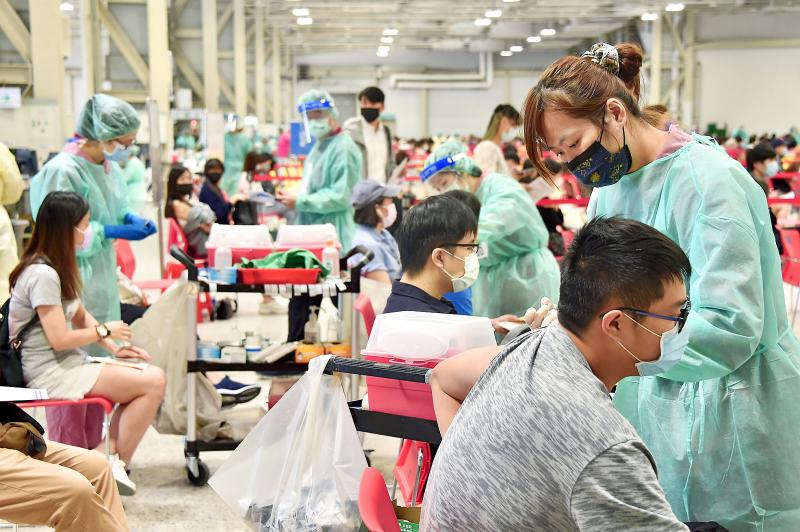The nation’s first-dose COVID-19 vaccination rate has exceeded 70 percent, with two-dose full vaccinations surpassing 30 percent, Minister of Health and Welfare Minister Chen Shih-chung (陳時中) said yesterday.
More than 16.4 million people, or 70.01 percent of Taiwan’s population of 23.43 million, have received at least one vaccine dose, and 30.87 percent, or 7.23 million people, have received two.
Chen said that 78.16 percent of people aged 65 or above had received at least one shot, and 67.57 percent had been fully vaccinated.

Photo: Tu Chien-jung, Taipei Times
The two-dose vaccination rate of the flight crew of Taiwanese airlines has reached 99 percent, with 90 percent of airport personnel having been fully vaccinated, said Chen, who also heads the Central Epidemic Command Center (CECC).
Taiwan yesterday received 902,100 doses of the Pfizer-BioNTech COVID-19 vaccine, the ninth shipment Taiwan has received of this brand.
It is part of 15 million doses ordered by the Hon Hai Precision Industry Co-affiliated Yong Lin Foundation, Taiwan Semiconductor Manufacturing Co, and the Buddhist Compassion Relief Tzu Chi Foundation, which are to be donated to the government for distribution.
Another shipment of the Pfizer-BioNTech vaccine is scheduled to arrive today, Chen said.
With the latest delivery, Taiwan has now received more than 6.8 million doses of the Pfizer-BioNTech vaccine and over 25.4 million COVID-19 vaccine doses from overseas, CECC data showed.
Taiwan yesterday reported six new COVID-19 cases, all contracted overseas, and zero deaths from the disease, the CECC said.
The six imported cases arrived in Taiwan from Japan, the US, the UK, Kyrgyzstan and Mongolia. They all tested positive during quarantine, the CECC said.

SHIPS, TRAINS AND AUTOMOBILES: The ministry has announced changes to varied transportation industries taking effect soon, with a number of effects for passengers Beginning next month, the post office is canceling signature upon delivery and written inquiry services for international registered small packets in accordance with the new policy of the Universal Postal Union, the Ministry of Transportation and Communications said yesterday. The new policy does not apply to packets that are to be delivered to China, the ministry said. Senders of international registered small packets would receive a NT$10 rebate on postage if the packets are sent from Jan. 1 to March 31, it added. The ministry said that three other policies are also scheduled to take effect next month. International cruise ship operators

HORROR STORIES: One victim recounted not realizing they had been stabbed and seeing people bleeding, while another recalled breaking down in tears after fleeing A man on Friday died after he tried to fight the knife-wielding suspect who went on a stabbing spree near two of Taipei’s busiest metro stations, Taipei Mayor Chiang Wan-an (蔣萬安) said. The 57-year-old man, identified by his family name, Yu (余), encountered the suspect at Exit M7 of Taipei Main Station and immediately tried to stop him, but was fatally wounded and later died, Chiang said, calling the incident “heartbreaking.” Yu’s family would receive at least NT$5 million (US$158,584) in compensation through the Taipei Rapid Transit Corp’s (TRTC) insurance coverage, he said after convening an emergency security response meeting yesterday morning. National

PLANNED: The suspect visited the crime scene before the killings, seeking information on how to access the roof, and had extensively researched a 2014 stabbing incident The suspect in a stabbing attack that killed three people and injured 11 in Taipei on Friday had planned the assault and set fires at other locations earlier in the day, law enforcement officials said yesterday. National Police Agency (NPA) Director-General Chang Jung-hsin (張榮興) said the suspect, a 27-year-old man named Chang Wen (張文), began the attacks at 3:40pm, first setting off smoke bombs on a road, damaging cars and motorbikes. Earlier, Chang Wen set fire to a rental room where he was staying on Gongyuan Road in Zhongzheng District (中正), Chang Jung-hsin said. The suspect later threw smoke grenades near two exits

The Forestry and Nature Conservation Agency yesterday launched a gift box to market honey “certified by a Formosan black bear” in appreciation of a beekeeper’s amicable interaction with a honey-thieving bear. Beekeeper Chih Ming-chen (池明鎮) in January inspected his bee farm in Hualien County’s Jhuosi Township (卓溪) and found that more than 20 beehives had been destroyed and many hives were eaten, with bear droppings and paw prints near the destroyed hives, the agency said. Chih returned to the farm to move the remaining beehives away that evening when he encountered a Formosan black bear only 20m away, the agency said. The bear